Growth hacking is the mother of all marketing buzzwords.
It’s the phrase you’ve probably heard it endlessly from new, edgy startup founders in your network.
You’ve probably seen it in articles online touting that “growth hacking” as the primary way to succeed.
And that’s the problem:
Marketers use the term “growth hacking” so much that it has become impossible to define or narrow down.
But despite this, real growth hacking beyond the buzzword is critical to taking a company from ten users to ten million.
Take a look at Facebook or Airbnb. They now have massive active user bases, and they got there by use growth-focused tactics.
But not any tactic that results in growth is automatically a growth hack.
With this cheat sheet, you’ll learn the basics of growth hacking. You can use this checklist to implement growth hacking strategies to take your business to new heights.
What exactly is growth hacking?
Growth hacking has quickly become one of the biggest buzzwords in the marketing jargon dictionary.
Everybody hears it and assumes that it’s just some random tactic that takes your business from zero to hero overnight.
But that’s far from reality.
Let me explain.
Marketing isn’t what it used to be.
Don Draper’s traditional marketing world of radio, newspaper, and television slowly disappeared, and growth hacking has developed in its place.
Sean Ellis is the inventor of the term “growth hacker” and the founder and CEO of GrowthHackers.com.
In a blog post that Sean published back in 2010, he wrote that a growth hacker is “a person whose true north is growth. Everything they do is scrutinized by its potential impact on scalable growth.”
He first coined the term when he was attempting to come up with a new job title.
He had experience helping businesses like Dropbox grow from nothing until they became huge. So for him, the title fit like a glove.
But he noticed that when leaving companies to aid new startups and repeat his growth hacking process, he couldn’t find replacements.
Typical marketers and sales reps didn’t have the ability to do it.
With strict budgets, deadlines, and timelines to follow, growth hacking wasn’t an option.
So, what concrete ideas or examples are considered growth hacks?
Take Dropbox for example.
When starting out, they were simply buying PPC ads and running social campaigns to drive traffic to their site that would ideally lead to sales.
But that wasn’t working. Customer acquisition costs were through the roof.
In short, it wasn’t sustainable growth. Sure, it was growth. They were gaining customers, attention, and traffic.
But long-term, that strategy wasn’t viable.
Instead, they started to implement a referral and reward-based program to scale their growth:
By using referrals from interested customers and rewarding them for their acquisition efforts, Dropbox exploded.
Their growth was now scalable, which is a key factor for successful growth hacking.
PayPal followed a similar growth strategy, offering their current customers $10 per friend they referred.
That means that PayPal didn’t have to spend millions, or even thousands, a year on PPC ads to generate customers.
They had their own customers do it for them, guaranteeing acquisition costs of just ten bucks a person.
Now they offer $5 for each friend that a user refers. All you have to do is send an email to a friend. The cost-benefit analysis is simple and easy for any new user to complete.
That’s simply amazing.
Twitter growth hacked their average user engagement by tapping into data and meticulously testing their strategy.
Looking at the data, they saw that current social users were more active on the platform when they followed 30 or more users.
They shared, commented, liked, and engaged more often.
Based on this data, they created a growth hacking strategy. When new users create accounts, they prompt them to follow tons of people based on their interests. Twitter builds a curated list of accounts that they can easily choose to follow.
This encourages users to follow more people and become active participants, increasing their growth and profit.
Growth hacking can come in many shapes, sizes, and approaches.
Let’s recap. Here are the key points about what exactly goes into growth hacking:
- Growth hacking creates sustainable, scalable growth.
- Growth hacking involves copious testing, continual tweaking, and iteration of the product, sales, and marketing strategy.
- Growth hacking involves all teams in your company working as one system to increase growth.
Does that seem broad?
Well, that’s because it is.
Growth hacking can be almost any scalable, sustainable growth action. It all depends on your business.
With that in mind, here is a checklist for your business to ensure that you are focusing on creating sustainable profits through growth hacking.
Tip #1: Break traditional goals into actionable steps
In order to attain their overarching growth strategy goals, growth hackers hone in on smaller goals that are SMART:
Specific, measurable, attainable, relevant and time-bound.
While setting goals like “becoming the best SaaS company in the world” isn’t bad, these kinds of goals aren’t actionable or specific enough.
What will be the driving sub-factors of that goal to help you achieve it?
Some examples of realistic SMART goals for growth hacking include:
- Increase blog traffic by 15% by the end of the month.
- Generate 250 leads from social media or an email campaign.
- Increase site content creation by 10%.
- Gain 10,000 new monthly visitors.
All of the above factors work together for the specific end goal of becoming the best SaaS company.
Breaking down goals into subgoals and even further sub-subgoals allows you to focus on what specific inputs will drive desired outputs.
Once you have listed these smaller, actionable goals, you can further break them down into separate, highly-defined subgoals.
These subgoals should be narrow enough that you can list them out as an individual task.
For example, say that your goal is to increase blog traffic by 15% by the end of the month. In that case, potential subgoals could include increasing content creation by 5% to beef up the blog and sending email campaigns and social media posts to promote the blog’s content.
By meticulously mapping out your overarching goals, actionable goals, and subgoals, you’ll have more than just a well-ordered project task list. You’ll also have a way to see what pieces of your strategy are driving results.
This foundational step will set you up for success.
When setting goals, growth hackers focus on their north star metric. But more specifically, they focus on what specific inputs will achieve desired outcomes:
For example, when playing a basketball game, your desired outcome is to win the game.
But that broad, unspecific goal is only achievable through micro-level subgoals. You need specific inputs that will generate the results that your overarching goals demand:
When looking at Spotify, we can bring this back into the business world:
The end goal for Spotify is to increase the usage of their service. When a user spends more time listening to content on Spotify, they become a better customer who pays more and sticks around longer.
If you break that down, you can come up with specific inputs that will achieve that final goal:
- Bring back users more often.
- Increase session times.
With SMART goals, you have to continually break down each goal until you generate specific inputs like creating playlists or giving new artists recommendations.
Start listing out your top goals and breaking them down into actionable steps that will lead to the result you desire.
Tip #2: Get creative as you outline ideas
The first step to listing out your top goals is to gather ideas.
Use a technique called mind storming to get started. Begin by taking out a blank sheet of paper and a pen, which can be more effective than using a computer or other device to take notes.
Write your top goal at the top of the page, but reword your goal as a question.
For example, if your goals involve landing more customers, write “how can I double my customer base in the next year?”
Then write out as many answers to the question as you can, which might include referrals, advertising, better SEO, rankings, links, and so on.
Don’t spend any time judging your answers. The first few will come to you very easily. Keep pushing on. Try to reach 20 answers at the very least.
Then, choose the best answer and form it into another question. If you choose “better SEO,” then write “how can I improve SEO within the next few months?”
Repeat the process again and again. Before you know it, you’ll have a main goal, subgoals, and sub-subgoals. You’ll know what to test and how to test it.
You can even bring your whole team together for the mind storming process. Allow everyone to first mind storm on their own.
Then, bring everyone together to discuss what they have written down. Expand on those ideas in the meeting. Then, get to testing.
It doesn’t have to cost you a dime, either. There are tons of growth hacking tests you can run for free.
If you want to boost conversions, try offering free trials and free content up front. That way, if leads aren’t ready to spend money yet, you can nurture them until they are.
Spotify accomplishes this by offering their premium features for free for 60 days.
Try offering a free e-book if they sign up for your newsletter. On top of that, make it easy for them to opt in. Keep forms simple to reduce friction, like so:
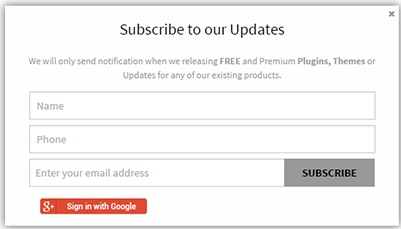
Test ideas shouldn’t stop there, though.
For example, Mint, a personal financial management company, developed a subgoal to get more traffic.
In order to get traffic, the company tried a content-driven approach toward trying to stimulate growth and promote brand awareness.
The brand started creating high-quality articles on a variety of finance topics like credit, investing, planning, and saving.
To make a long story short, they tested a blog (which they now call MintLife Blog), and it took off.
Because of the blog, Mint became a huge player in the finance world.
If you’re looking for content growth hacks like Mint was, check out these content marketing tactics that can help you boost your brand.
From there, work on turning your ideas into actionable experiments, just like Mint did.
Tip #3: Turn your ideas into experiments
Once you’ve identified your goals, subgoals, sub-subgoals, and how you’re going to test them, you need to start running experiments.
This is as easy as taking it back to the basics with the scientific method. This will help you determine the success of your test.
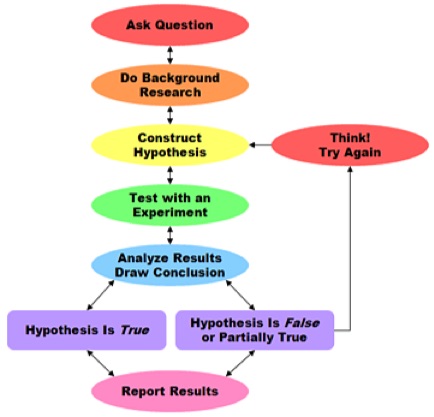
You were asking questions when you were coming up with goals. Next, ask questions about how you can test them.
What tests should you run? Who can help you run them? Where should you run them?
Then, do background research that can help you create a plan for answering those questions. Don’t start from scratch.
Research the best methods and resources that you can use to answer your questions. Search the Internet for ways that other companies have run similar tests in the past.
Use your research to finalize a plan for your brand. Construct a hypothesis about what will happen. Think, “If _____[I do this] _____, then _____[this]_____ will happen.”
Next, test your hypothesis by actually conducting an experiment. Your experiment has to be fair. Only change one factor at a time and repeat experiments to confirm results.
This is where A/B tests (or split testing) come in. Split test headlines on your blog. Find out which headlines convert better.
You could even run split tests with your Facebook ads to compare different versions of your ad for your next campaign.
You could even run multiple product iterations to customer segments.
Analyze your findings and draw a conclusion. Was your hypothesis correct?
Finally, communicate your results with the rest of your team. Adjust your efforts depending on the results of the test.
It might be a long road, but it’s worth it.
Airbnb growth hacked and tested new sites, and that eventually led the company to use Craigslist to share rentals.
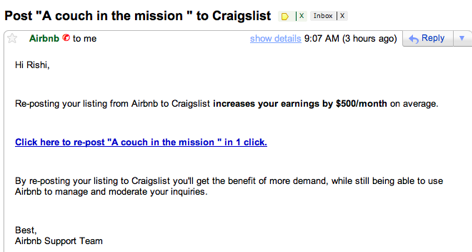
However, before finding this Craigslist growth hack, the company experimented for years by distributing flyers or going door to door.
Be patient with your experiments and don’t be afraid to test new things.
To figure out what your next move is going to be, use the ICE test.
Tip #4: Use the ICE test to inform your next move
You could spin your wheels with small tests that don’t move the needle. But you don’t want to do that.
Instead, you should be looking for the biggest impact.
That way, you won’t waste your time, resources, or money on the tests that don’t have the biggest payoff.
This is where the ICE test comes in.
The ICE test is a framework that helps you prioritize testing. Sean Ellis created this method, and the GrowthHackers team uses it frequently.
You can use it to find out which test will have the largest stimulus for growth.
ICE stands for impact, confidence, and ease.

Here’s a breakdown of each piece of the pie.
Impact: How impactful do you expect your test to be? This is the possible impact that your idea will have on the brand as a whole if the test is a “win.”
Confidence: How sure are you that your test will prove your hypothesis? Try to be objective whenever you choose a confidence level.
Do you have reliable proof that your test could work? Then give your idea a higher confidence score.
Do you lack reliable proof? Then give it a lower score.
Ease: How easily can you launch this test? How many resources would you need, and what kind of resources would be necessary?
The more resources you’ll need, the lower the score should be. If you can complete your test with a smaller amount of resources, go ahead and make this score higher.
Grade each of these criteria from one to ten. The average score is the ICE score.
Let’s say that these are some of your goals/test ideas:
- Create an e-book. (I=8, C=7, E=2) Average ICE score=5.67
- Film marketing videos. (I=9, C=6, E=1) Average ICE score=5.33
- Write new blog posts. (I=7, C=7, E=4) Average ICE score=6
Based on these ICE scores, you should prioritize these growth hacks in this order:
- Write new blog posts.
- Create an e-book.
- Film marketing videos.
The ICE score isn’t a flawless system for prioritizing individual ideas. You should think of it as a system of “relative prioritization.”
The goal of the ICE test is to prevent you or your team from attempting to fine-tune the score. The score you come up with will show you which tests you should run first.
Tip #5: Analyze, improve, and repeat
As a growth hacker, you will test everything.
It’s just part of the nature of a true growth hacker.
As you master A/B testing, you’ll start running multiple tests at the same time, such as landing and pricing page designs and targeting leads.
For growth hackers, this breadth and frequency of testing is par for the course.
Using a tool like Optimizely, you can manage multiple testing campaigns at one time, reducing your likelihood of missing any fundamental developments.
It can be easy to get too caught up in the testing cycle and forget to take the time to slowly analyze the results and pinpoint precisely what is (or isn’t) working.
Be patient. This process is all about trial and error.
Rely on your analytics data to fine-tune and improve your approach.
Then, it’s time to repeat the testing cycle. You can either start a new test or create an optimized version of a previous test.
As long as you keep following this system (testing, analyzing your data, refining your approach and retesting), you should see success through your persistence.
You’ll go through tests and experiments, both big and small, and wade through all kinds of data. As you do so, don’t lose the sight of the big picture.
Your product or service should be of the very highest quality for your users at any given time, and this may mean changing and evolving.
For example, Facebook has changed a lot since it originally launched on college campuses in 2004. And it continues to change today with additions like live video and other features that users crave.
It’s why they have billions of people using their platform everyday.
Tip #6: Leverage your strengths
Tim Ferris, author of the 4-Hour Workweek, says, “It is far more lucrative and fun to leverage your strengths instead of attempting to fix all the chinks in your armor….Focus on better use of your best weapons instead of constant repair.”
For example, imagine that you are working on two projects and are trying to decide which one to prioritize.
Option one: You could add a new referral program to your website’s landing page.
Option two: You could send out an email to everyone in your contacts database.
You have just over 50,000 people in the contacts database, and you’re a pro with your email distribution system.
On the other hand, it would take you at least a few days to design and edit a few different mockups for the referral program.
A/B testing, programming, and implementation will also take time.
You get the picture.
In this situation, your strength is the size of your contact database and your competency with the e-mail system. So focus on that.
Don’t be afraid to cut out any segments that aren’t working, either.
If you’ve been putting a lot of time and effort into testing and redesigning your pricing page without any noticeable increases in views, it’s time to take a break and try something else.
Remember:
Growth hacking is about sustainable inputs and explosive outputs. If you aren’t seeing outputs from your inputs, don’t do it.
Growth hackers focus on growth as their true north.
Conclusion
Growth hacking has taken over the Internet, leaving little room for understanding and lots of room for confusion.
It’s hard to pinpoint a concrete definition of growth hacking.
But that’s simply because growth hacking will be vastly different from one business to another.
In short, growth hacking is involving all teams, systems, and processes in your business to test, iterate, and improve your growth.
Whether it’s growth in sales, reach, brand awareness, or engagement, any focus on scalable growth tactics is growth hacking.
Follow this checklist to prepare your business for successful, scalable growth hacking.
What growth hacking projects will you be trying this year?
About the Author: Neil Patel is the cofounder of Neil Patel Digital.
from The Kissmetrics Marketing Blog http://ift.tt/2HnadAF
via IFTTT
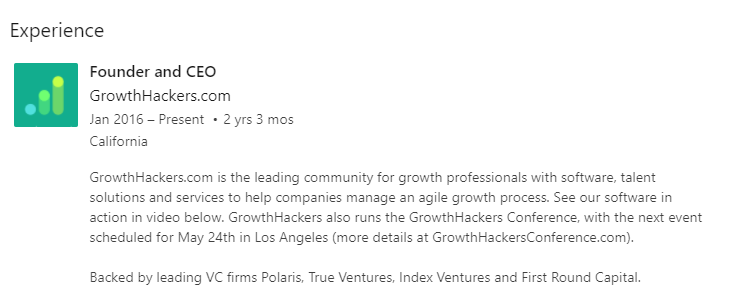





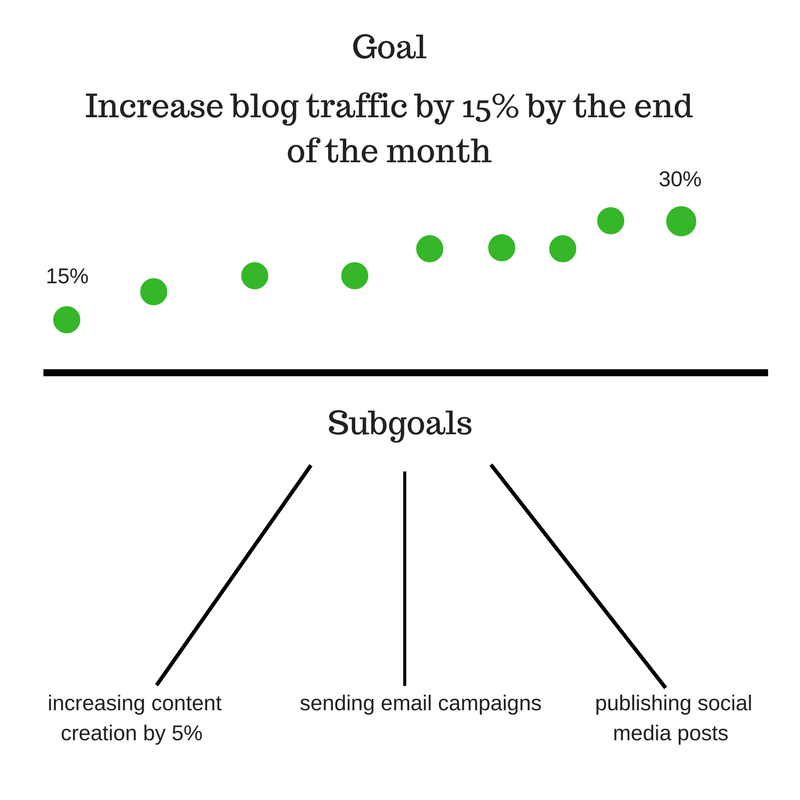


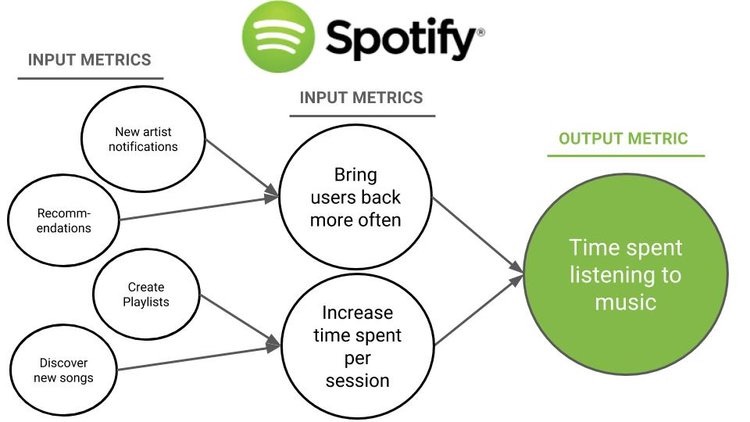



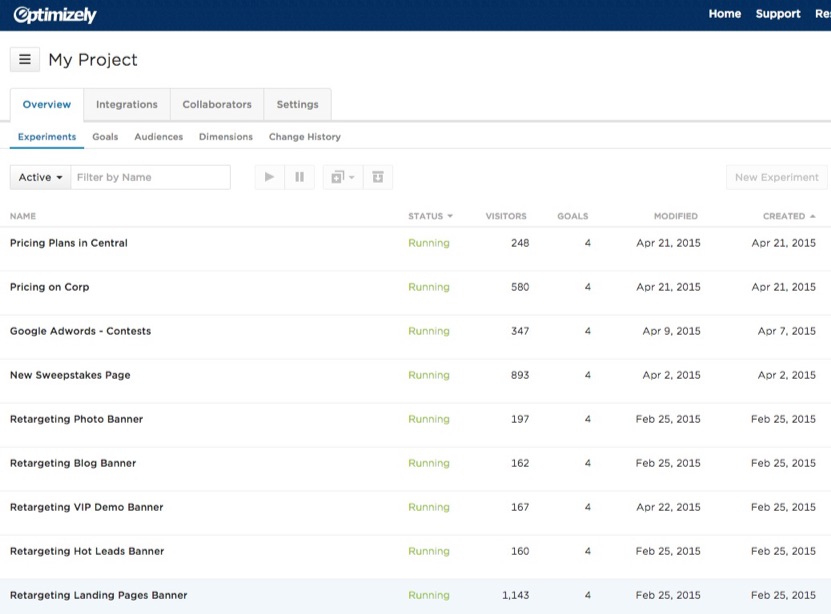
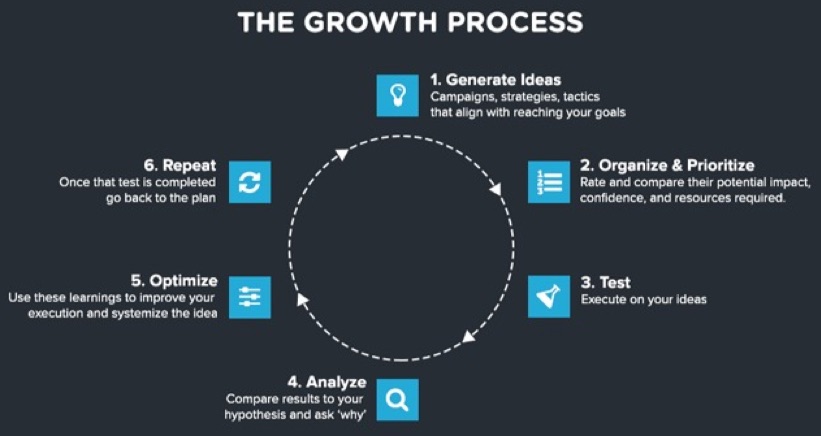
No comments:
Post a Comment